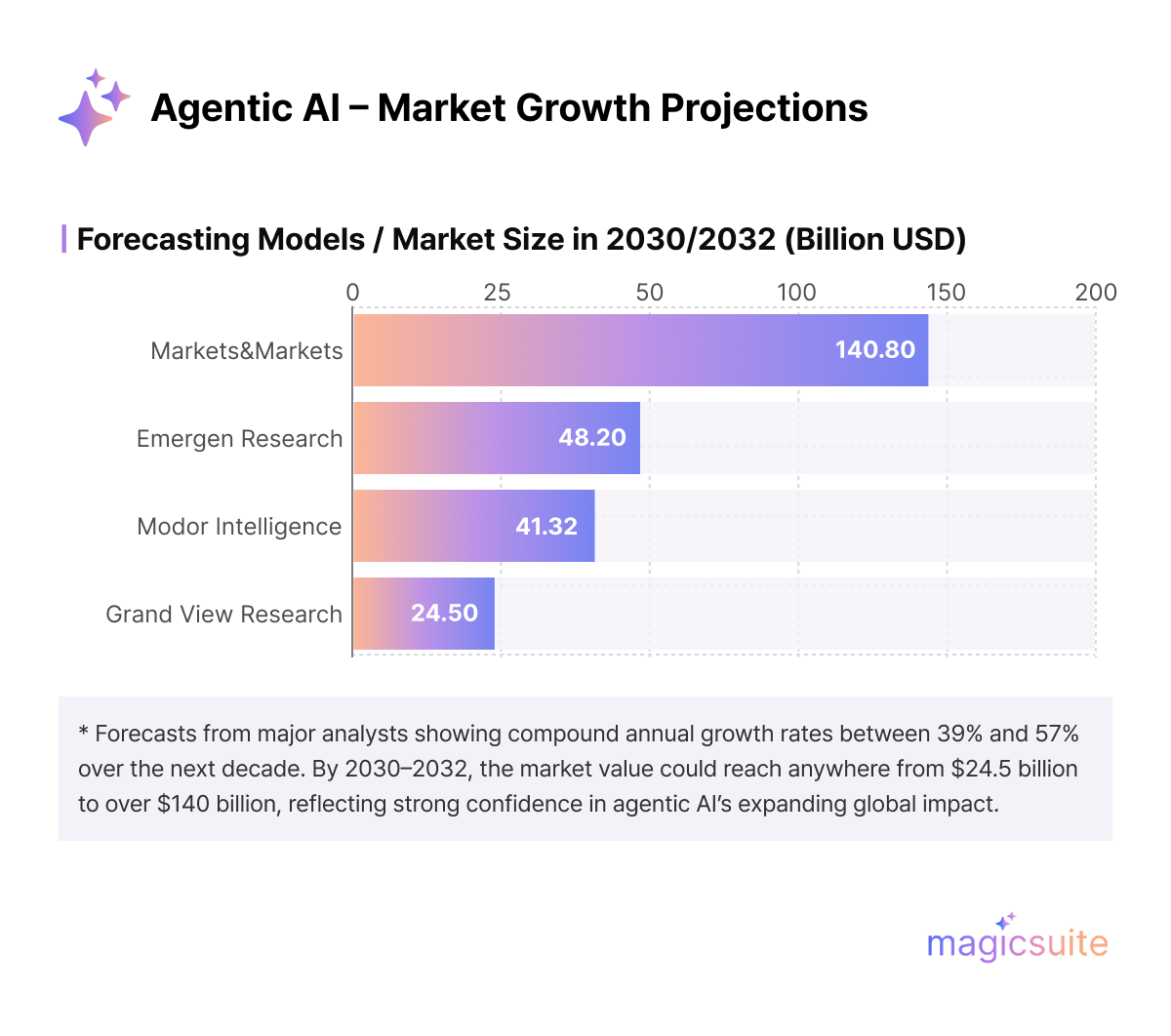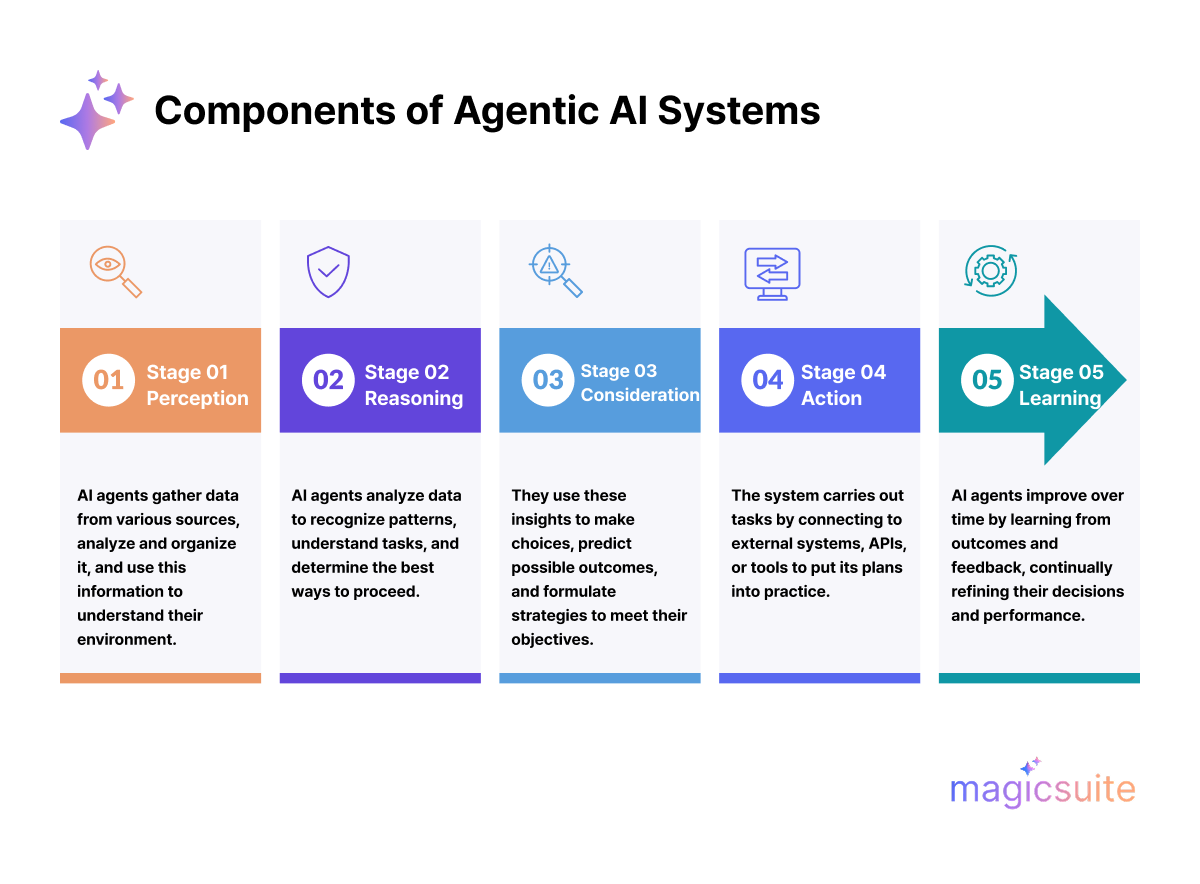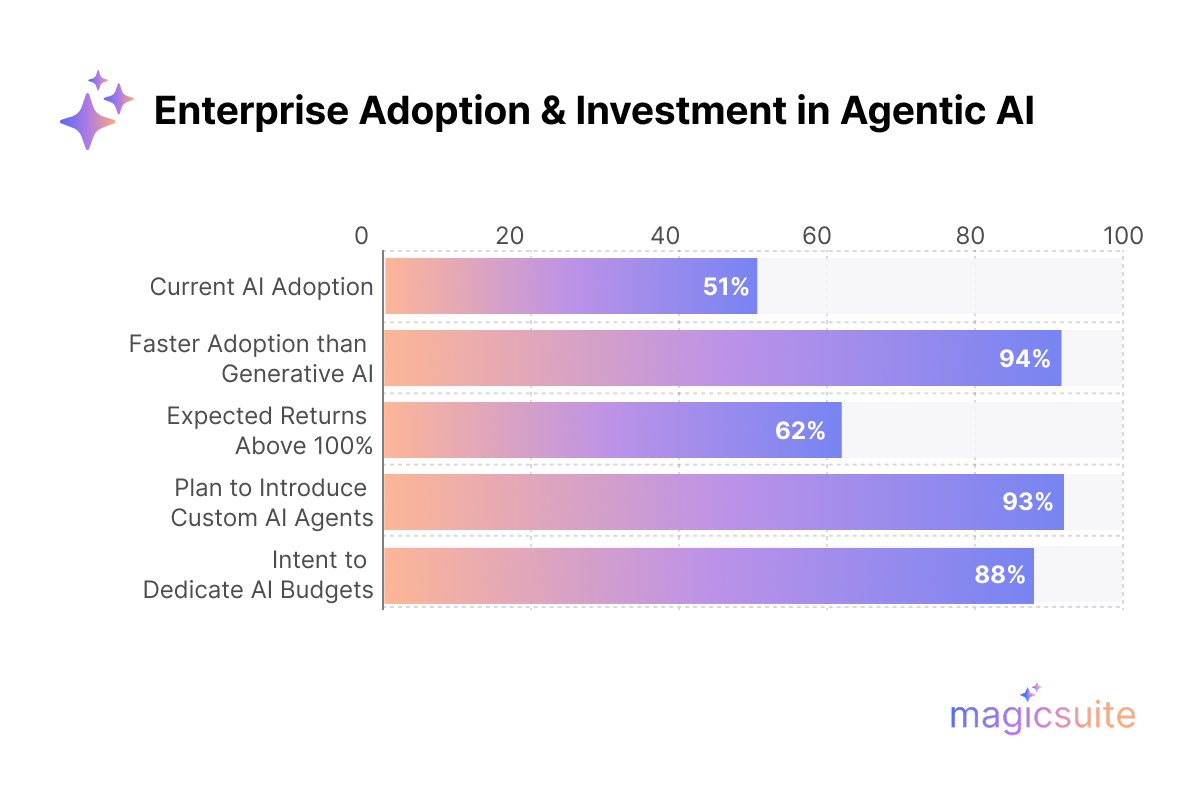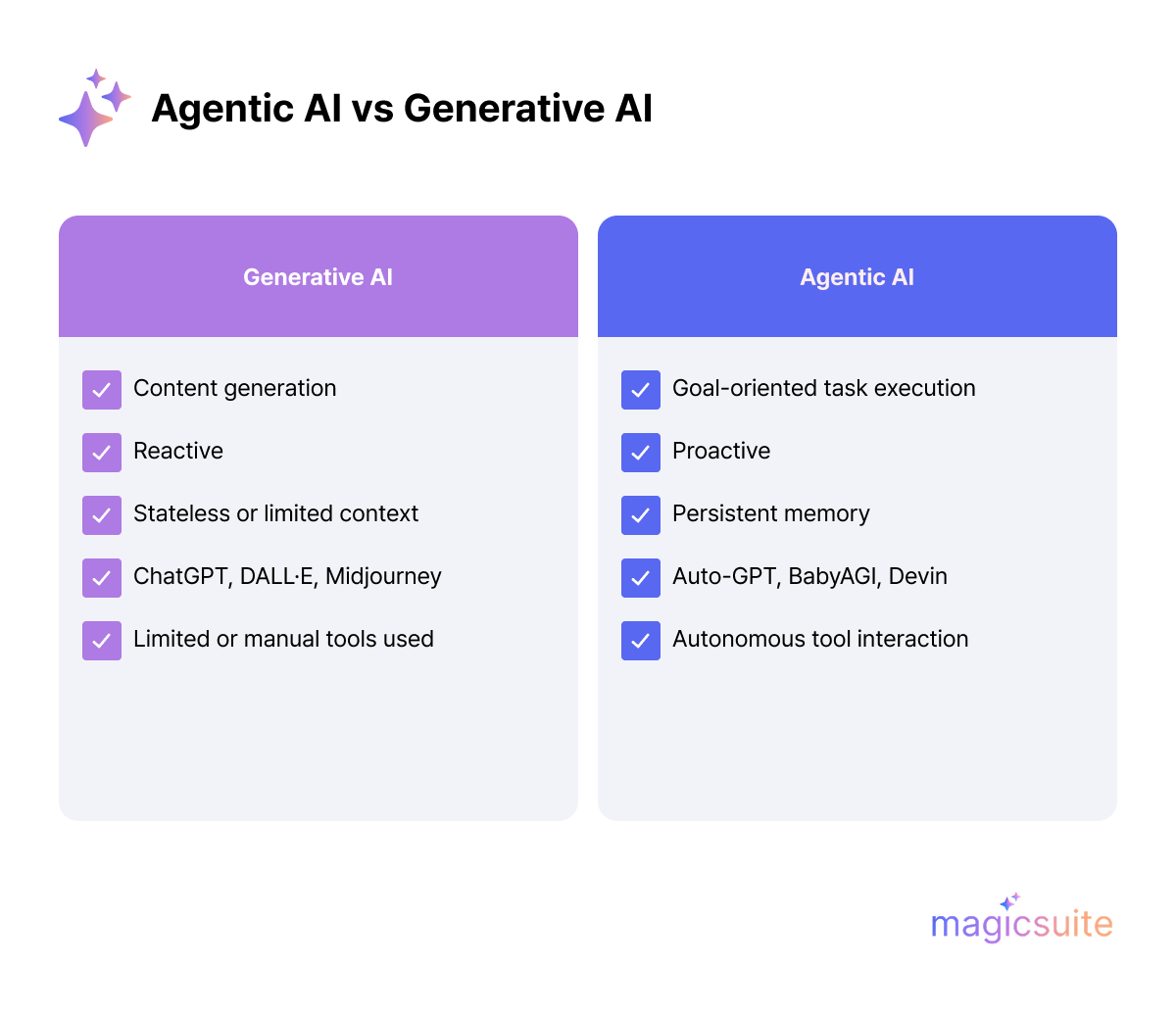Discover the transformative world of agentic AI. Learn its definition, key characteristics, practical applications, and how it differs from generative AI. Explore real-world examples and the future of autonomous AI systems.

While most people are familiar with generative AI tools like ChatGPT and Midjourney, agentic AI represents a significant leap forward in how machines interact with the world, make decisions, and execute tasks with minimal human intervention.
Unlike traditional AI that waits for human prompts or follows predetermined rules, agentic AI operates with remarkable autonomy. This article examines the concept of agentic AI, its practical applications, examples, and its differences from generative AI.
Agentic AI refers to artificial intelligence systems that operate as autonomous agents. These systems are not limited to generating content or responding to prompts. They can set goals, make decisions, plan actions, and execute tasks over time, often interacting with other systems or environments.

Key Characteristics of Agentic AI:
Unlike traditional AI models that react to inputs, agentic systems are proactive. They behave more like digital employees or assistants who can manage projects, coordinate resources, and adapt to changing circumstances.
“Agentic AI is the bridge between passive intelligence and active problem-solving.” — MIT Technology Review
Agentic AI is built on a combination of advanced technologies:
These components enable the AI to function as an intelligent agent. For instance, an agentic AI might be tasked with planning a marketing campaign. It would:
All of this can happen with minimal human oversight.
Agentic AI systems typically operate through five key stages that distinguish them from traditional AI approaches:


Over half (51%) of companies already use AI agents, and nearly all (94%) believe they’ll adopt agentic AI even faster than generative AI. 62% of executives also expect more than double returns on their agentic AI investments. 93% of software execs plan to deploy custom AI agents within their organizations. 88% of enterprises intend to set dedicated budgets for agentic systems in 2025.
Bottom Line:
Enterprise adoption of agentic AI is rapidly accelerating, with strong confidence in both its strategic value and ROI. Here are some major use cases, backed by real-world impact:
Financial institutions utilize agentic AI to monitor markets, identify investment opportunities, and execute trades in mere milliseconds. Major banks, such as JPMorgan, utilize AI agents like the LOXM system to analyze real-time market data and execute trades more quickly and accurately than humans. LOXM also lowers costs and can handle huge trading volumes with minimal errors.
Another example is Bank of America’s AI assistant, Erica. Erica works around the clock to answer customer questions about balances, payments, and possible fraud. Since its launch, Erica has managed over 1 billion customer interactions, cut call center traffic by 17%, and boosted customer engagement by 30%.
Healthcare represents one of the most promising frontiers for the implementation of agentic AI. The global agentic AI in healthcare market was valued at $538.51 million in 2024 and is projected to reach $4.96 billion by 2030, growing at a CAGR of 45.56%.
How Agentic AI Powers Healthcare
Agentic AI chatbots offer 24/7 personalized customer support, resolve disputes, and provide tailored recommendations—all without requiring human intervention. These systems can proactively address shopping cart abandonment or product returns, thereby boosting conversion rates and customer satisfaction.
Amazon's "Buy for Me" capability enables Alexa to automatically select and purchase items based on user preferences, eliminating the need to navigate listings manually.
Also read: 10 Lessons Businesses Can Learn from Amazon Customer Service
Customer service is now the front line for agentic AI deployment, with 49% of organizations planning to adopt autonomous agents to manage inquiries and support tasks. These advanced systems can:
Businesses that adopt agentic AI for support experience significant improvements, including higher customer satisfaction, faster resolution times, and more efficient operations.
The transportation sector is undergoing a significant transformation through the implementation of agentic AI. Self-driving and autonomous systems process sensor data instantly to manage acceleration, braking, and routing, dynamically adapting to new conditions as they arise.
Intelligent agents now optimize inventory, automatically reorder supplies, and plan delivery routes based on weather conditions and traffic patterns. Companies like Tesla use agentic AI to monitor and adjust assembly lines in real-time. If defects are detected, the AI can autonomously stop production, correct the issue, and then resume operations. This approach enabled Tesla to produce over 1.8 million vehicles annually.
Agentic AI continuously monitors IT environments to detect threats, isolate compromised devices, and initiate responses—even before human teams are aware of the issue.
Intelligent agents customize travel itineraries, predict price trends, and even proactively handle disruptions, ensuring smoother journeys for travelers.
While both agentic and generative AI rely on large language models, their functionalities differ significantly.

Generative AI and agentic AI aren’t rivals—they often work hand in hand.
When combined:
Example:
In a customer service system, generative AI could draft responses to customer questions, while agentic AI decides which queries to answer first, routes tickets, and ensures every customer gets reliable help. This teamwork amplifies the capabilities of AI systems, enabling them to communicate effectively and manage complex workflows.
Read more in Conversational vs. Traditional Customer Service: Pros and Cons
Agentic AI is poised to transform the way businesses operate, make informed decisions, and assist customers. Soon, companies will utilize intelligent AI agents that can handle complex tasks with minimal human intervention. They will also be designed for specific industries, making them even more helpful.
Experts predict that agentic AI could add up to $4.4 trillion to the world’s economy by 2030. By 2027, up to half of routine business tasks may be automated, and by 2028, one in three business software tools will utilize agentic AI. This technology is bringing in a new era of smarter, faster businesses.
The future isn't just intelligent—it's agentic.
Agentic AI is designed to perform tasks autonomously, while generative AI focuses on content creation. Agentic systems can plan, act, and adapt over time, whereas generative models typically respond to single prompts.
While agentic AI offers powerful capabilities, it also introduces risks related to autonomy and control. Researchers are actively working on AI alignment and safety protocols to ensure responsible use.
Examples include Auto-GPT, BabyAGI, and Devin. These systems can perform complex tasks like coding, research, and project management.
Agentic AI may automate certain roles, especially in knowledge work. However, it is more likely to augment human capabilities, allowing people to focus on creative and strategic tasks.
You can experiment with open-source tools like Auto-GPT or BabyAGI. For businesses, platforms like LangChain and Cognition Labs offer enterprise solutions.

Hanna is an industry trend analyst dedicated to tracking the latest advancements and shifts in the market. With a strong background in research and forecasting, she identifies key patterns and emerging opportunities that drive business growth. Hanna’s work helps organizations stay ahead of the curve by providing data-driven insights into evolving industry landscapes.